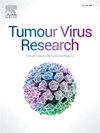Regulation of epithelial growth factor receptors by the oncoprotein E5 during the HPV16 differentiation-dependent life cycle
IF 8.1
Q1 VIROLOGY
引用次数: 0
Abstract
Human papillomavirus (HPV) 16 infection initiates upon viral entry into the basal cells of the epithelium. The virus manipulates signaling pathways to complete its life cycle, which depends on cellular differentiation. The virus expresses the oncoproteins E5, E6, and E7 to promote immune evasion, cell cycle progression, apoptosis inhibition, and viral replication. The least studied viral oncoprotein is E5 (16E5), which can regulate epithelial growth factor receptor (GFR) signaling pathways. GFRs such as transforming growth factor-beta receptor (TGFBR), epidermal growth factor receptor (EGFR), and keratinocyte growth factor receptor (KGFR) have essential roles in cell growth, differentiation, and proliferation. These receptors obtain their ligands from the microenvironment, and once activated, regulate cellular behavior in the epithelium. GFRs therefore represent valuable targets for the virus to establish and maintain a cellular environment supportive of infection. The ability of 16E5 to regulate proliferation and differentiation varies through the differentiating epithelium, making it necessary to adequately describe the association between 16E5 and GFRs. Here we summarize the regulation of GFR signaling pathways by 16E5, discuss the roles of stromal growth factors, and outline unresolved questions over cellular differentiation and proliferation during the HPV life cycle.
肿瘤蛋白E5在HPV16分化依赖生命周期中对上皮生长因子受体的调控
人乳头瘤病毒(HPV) 16感染开始时,病毒进入上皮基底细胞。病毒操纵信号通路来完成它的生命周期,这取决于细胞分化。该病毒表达癌蛋白E5、E6和E7,促进免疫逃避、细胞周期进展、细胞凋亡抑制和病毒复制。研究最少的病毒癌蛋白是E5 (16E5),它可以调节上皮生长因子受体(GFR)信号通路。转化生长因子-受体(TGFBR)、表皮生长因子受体(EGFR)和角质细胞生长因子受体(KGFR)等gfr在细胞生长、分化和增殖中起着重要作用。这些受体从微环境中获得配体,一旦被激活,就会调节上皮细胞的行为。因此,gfr是病毒建立和维持有利于感染的细胞环境的宝贵靶标。16E5调节增殖和分化的能力因分化上皮而异,因此有必要充分描述16E5与gfr之间的关系。本文总结了16E5对GFR信号通路的调控,讨论了基质生长因子的作用,并概述了HPV生命周期中细胞分化和增殖的未解决问题。
本文章由计算机程序翻译,如有差异,请以英文原文为准。
求助全文
约1分钟内获得全文
求助全文
来源期刊

Tumour Virus Research
Medicine-Infectious Diseases
CiteScore
6.50
自引率
2.30%
发文量
16
审稿时长
56 days
 求助内容:
求助内容: 应助结果提醒方式:
应助结果提醒方式:


